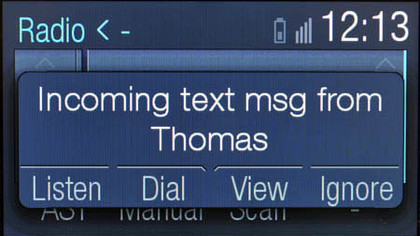6 techy toys that'll make your next car safer to drive
But won't stop old ladies from crossing in front of you

What will it take to make cars safer? That depends on who you ask. The European New Car Assessment Programme (Euro NCAP) and the US National Highway Traffic Safety Administration (NHTSA) safety boards have insisted for years that cars use more advanced technology.
This is partly a political debate of course - how much can governments demand that car manufacturers use a particular technology?
Yet, the statistics show that most accidents occur in a predictable way: rear collisions when drivers back-up in car parks, side-swipes when someone changes a lane, and roll-overs caused by sudden stops.
Here are some of the biggest safety technologies designed to avoid these avoidable accidents:

1. Rear-view back-up camera
In the US, a rear-view back-up camera will be required in all 2014 models. A dashboard screen shows what is behind the car. According to Ed Kim, vice president of industry analysis at Auto Pacific, the costs of the materials to make rear-view cameras is now more reasonable.
And the sleek design (and resulting poor visibility) of many new cars - especially those by Toyota - have made back-up cameras more necessary.

2. Rear-view back-up intervention
Seeing what is behind the car is one thing, but only one current vehicle has the technology to stop the car when there is an obstacle behind you. The 2013 Infiniti JX will sense movement and obstruction. You'll hear an audible chime first, then the accelerator will push back, and the car will stop. Making a similar system intervene in case of a rear collision would reduce accidents.
Sign up for breaking news, reviews, opinion, top tech deals, and more.
Many vehicles already have an alert system. "Rear cross path warning is becoming increasingly common and relatively inexpensive to implement because it usually uses the same sensors as the blind spot monitor system," says Kim.

3. Texting deterrents
Distracted driving has a common cause: texting on your phone. In many countries, texting while you drive is illegal, but that has not prevented everyone from giving into the temptation. Short of transmitting a counter-signal to disable your phone, several vehicle manufacturers have figured out how to deter texting.
On many newer Ford models, the car can read your text messages, and you can punch an automated response like "call me back later" without looking at your phone. Having some form of text messaging deterrent in every new car could reduce serious accidents from happening.

4. Lane keeping and intervention
Infiniti also paved the way for lane-keeping intervention, a technology that is also available on many Mercedes-Benz models. Sensors in the car can spot oncoming traffic in the next lane, and even identify lane markings (and they can tell if you have flipped the turn signal indicator).
Mandating lane-keeping measures would be expensive, but Kim says the technology is similar to blind spot detection, which is now becoming almost universal in new cars. Lane keeping nudges you back in your lane, usually by applying a slight brake pressure to the tyres closest to that lane.

5. Pre-collision alerts and intervention
Many mid-quality and high-end vehicles now use a forward-sensing radar that can tell if you are about to crash, and can automatically apply the brakes. Unfortunately, entry-level cars such as the Ford Fiesta often do not include the feature, especially at the base price level. Requiring some form of collision detection or intervention could become the new seat belt technology over the next 20 years, making it rare for a vehicle to plow straight into another car on the highway.
"The Honda Accord, Subaru Legacy, and Chevrolet Equinox all offer it at affordable prices. The less expensive systems warn drivers of an impending frontal impact, while upscale systems can also actively brake the vehicle. Often, these systems are tied to adaptive cruise control systems as they often share the same hardware," says Kim.

6. Substance abuse detection
Easily one of the most controversial measures, a detection system that can tell if you have become inebriated could lock the ignition and prevent you from driving. The political issue has to do with privacy and freedom: how inebriated would you have to be to lock the car down? And, is this information that could be fed to the authorities?
Yet, some level of intervention in all new cars could help - even if it is a warning system or a way to notify another driver about your incapacitated state.

John Brandon has covered gadgets and cars for the past 12 years having published over 12,000 articles and tested nearly 8,000 products. He's nothing if not prolific. Before starting his writing career, he led an Information Design practice at a large consumer electronics retailer in the US. His hobbies include deep sea exploration, complaining about the weather, and engineering a vast multiverse conspiracy.